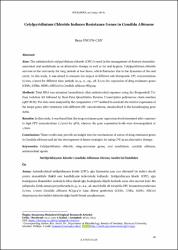Cetylpyridinium Chloride Induces Resistance Genes in Candida Albicans
Özet
Aim: The antimicrobial cetylpyridinium chloride (CPC) is used in the management of denture stomatitisassociated oral candidiasis as an alternative therapy as well as for oral hygiene. Cetylpyridinium chloride
survives in the oral cavity for long periods at low doses, which fluctuates due to the dynamics of the oral
cavity. In this study, it was aimed to evaluate the impact of different sub-therapeutic CPC concentrations
(1/100, 1/200) for different time periods (0.,5., 2., 24., 48. h) on the expression of drug-resistance genes
(CDR1, CDR2, MDR1, ERG11) in Candida albicans SC5314.
Method: Total RNA was extracted immediately after antimicrobial exposure using the Biospeedy® TriEasy Isolation Kit followed by Real-Time Quantitative Reverse Transcription polymerase chain reaction
(qRT-PCR). The data were analyzed by the comparative 2-ΔΔCT method to calculate the relative expression of
the target genes after treatment with different CPC concentrations, standardized to the housekeeping gene
Actin.
Results: In this study, it was found that the drug resistance gene expression levels increased after exposure
to high CPC concentrations (1/100) for 48 h, whereas the gene expression levels were downregulated at
1/200.
Conclusion: These results may provide an insight into the mechanisms of action of drug-resistance genes
in Candida albicans and aid the development of future strategies for using CPC as an alternative therapy. Amaç: Antimikrobiyal setilpridinyum klorür (CPC), ağız hijyeninin yanı sıra alternatif bir tedavi olarak
protez stomatitiyle ilişkili oral kandidiyazis tedavisinde kullanılır. Setilpridinyum klorür (CPC), ağız
boşluğunun dinamikleri nedeniyle dilue olarak ağız boşluğunda düşük dozlarda uzun süre mevcut kalır. Bu
çalışmada, farklı zaman periyotlarında (0.,5., 2., 24., 48. saat) farklı alt terapötik CPC konsantrasyonlarının
(1/100, 1/200) Candida albicans SC5314'te ilaca direnç genlerinin (CDR1, CDR2, MDR1, ERG11)
ekspresyonu üzerindeki etkisinin değerlendirilmesi amaçlanmıştır.
Yöntem: Toplam RNA, antimikrobiyal ile maruziyetten hemen sonra Biospeedy® Tri-Easy Isolation Kit ve
ardından qRT-PCR kullanılarak ekstre edildi. Bu veriler, farklı CPC konsantrasyonları ile muameleden sonra
hedef genlerin nispi ekspresyonunu hesaplamak için karşılaştırmalı 2-ΔΔCT yöntemiyle analiz edildi, Aktin
housekeeping genine standardize edildi.
Bulgular: Bu çalışmada, 48 saat boyunca, yüksek CPC konsantrasyonuna (1/100) maruz kalan örneklerde
Candida ilaç direnci gen ekspresyon seviyelerinin arttığı, buna karşın 1/200 konsantrasyonunda
bekletildiğinde azaldığı bulundu.
Sonuç: Bu sonuçlar, Candida albicans'ta ilaca dirençli genlerin etki mekanizmaları hakkında bir fikir
verebilir ve alternatif bir tedavi olarak CPC'yi kullanmak için gelecekteki stratejilerin geliştirilmesine
yardımcı olabilir.
Sayı
19Bağlantı
https://hdl.handle.net/11363/4733Koleksiyonlar
Aşağıdaki lisans dosyası bu öğe ile ilişkilidir:


















